[English] 日本語
 Yorodumi
Yorodumi- PDB-3zhg: Crystallographic structure of the native mouse SIGN-R1 CRD domain -
+ Open data
Open data
- Basic information
Basic information
| Entry | Database: PDB / ID: 3zhg | ||||||
|---|---|---|---|---|---|---|---|
| Title | Crystallographic structure of the native mouse SIGN-R1 CRD domain | ||||||
 Components Components | (CD209 ANTIGEN-LIKE PROTEIN B) x 2 | ||||||
 Keywords Keywords |  IMMUNE SYSTEM / C-LECTIN CRD / CAPSULAR POLYSACCHARIDE. IMMUNE SYSTEM / C-LECTIN CRD / CAPSULAR POLYSACCHARIDE. | ||||||
| Function / homology |  Function and homology information Function and homology informationdetection of yeast / (1->3)-beta-D-glucan binding /  fucose binding / fucose binding /  phagocytosis, recognition / phagocytosis, recognition /  polysaccharide binding / polysaccharide binding /  D-mannose binding / detection of bacterium / positive regulation of phagocytosis / D-mannose binding / detection of bacterium / positive regulation of phagocytosis /  endocytosis / positive regulation of tumor necrosis factor production ...detection of yeast / (1->3)-beta-D-glucan binding / endocytosis / positive regulation of tumor necrosis factor production ...detection of yeast / (1->3)-beta-D-glucan binding /  fucose binding / fucose binding /  phagocytosis, recognition / phagocytosis, recognition /  polysaccharide binding / polysaccharide binding /  D-mannose binding / detection of bacterium / positive regulation of phagocytosis / D-mannose binding / detection of bacterium / positive regulation of phagocytosis /  endocytosis / positive regulation of tumor necrosis factor production / endocytosis / positive regulation of tumor necrosis factor production /  immune response / external side of plasma membrane / immune response / external side of plasma membrane /  membrane / membrane /  metal ion binding metal ion bindingSimilarity search - Function | ||||||
| Biological species |   MUS MUSCULUS (house mouse) MUS MUSCULUS (house mouse) | ||||||
| Method |  X-RAY DIFFRACTION / X-RAY DIFFRACTION /  SYNCHROTRON / SYNCHROTRON /  MOLECULAR REPLACEMENT / Resolution: 1.87 Å MOLECULAR REPLACEMENT / Resolution: 1.87 Å | ||||||
 Authors Authors | Silva-Martin, N. / Bartual, S.G. / Hermoso, J.A. | ||||||
 Citation Citation |  Journal: Structure / Year: 2014 Journal: Structure / Year: 2014Title: Structural Basis for Selective Recognition of Endogenous and Microbial Polysaccharides by Macrophage Receptor Sign-R1. Authors: Silva-Martin, N. / Bartual, S.G. / Ramirez-Aportela, E. / Chacon, P. / Park, C.G. / Hermoso, J.A. | ||||||
| History |
|
- Structure visualization
Structure visualization
| Structure viewer | Molecule:  Molmil Molmil Jmol/JSmol Jmol/JSmol |
|---|
- Downloads & links
Downloads & links
- Download
Download
| PDBx/mmCIF format |  3zhg.cif.gz 3zhg.cif.gz | 130.1 KB | Display |  PDBx/mmCIF format PDBx/mmCIF format |
|---|---|---|---|---|
| PDB format |  pdb3zhg.ent.gz pdb3zhg.ent.gz | 106.3 KB | Display |  PDB format PDB format |
| PDBx/mmJSON format |  3zhg.json.gz 3zhg.json.gz | Tree view |  PDBx/mmJSON format PDBx/mmJSON format | |
| Others |  Other downloads Other downloads |
-Validation report
| Arichive directory |  https://data.pdbj.org/pub/pdb/validation_reports/zh/3zhg https://data.pdbj.org/pub/pdb/validation_reports/zh/3zhg ftp://data.pdbj.org/pub/pdb/validation_reports/zh/3zhg ftp://data.pdbj.org/pub/pdb/validation_reports/zh/3zhg | HTTPS FTP |
|---|
-Related structure data
- Links
Links
- Assembly
Assembly
| Deposited unit | 
| ||||||||
|---|---|---|---|---|---|---|---|---|---|
| 1 | 
| ||||||||
| 2 | 
| ||||||||
| 3 | 
| ||||||||
| 4 | 
| ||||||||
| Unit cell |
|
- Components
Components
| #1: Protein | Mass: 17973.301 Da / Num. of mol.: 3 / Fragment: CRD, RESIDUES 191-325 Source method: isolated from a genetically manipulated source Source: (gene. exp.)   MUS MUSCULUS (house mouse) MUS MUSCULUS (house mouse)Cell line (production host): CHINESE HAMSTER OVARY (CHO) CELLS Production host:   CRICETULUS GRISEUS (Chinese hamster) / Tissue (production host): OVARY / References: UniProt: Q8CJ91 CRICETULUS GRISEUS (Chinese hamster) / Tissue (production host): OVARY / References: UniProt: Q8CJ91#2: Protein | | Mass: 18001.314 Da / Num. of mol.: 1 / Fragment: CRD RESIDUES 190-325 Source method: isolated from a genetically manipulated source Source: (gene. exp.)   MUS MUSCULUS (house mouse) MUS MUSCULUS (house mouse)Cell line (production host): CHINESE HAMSTER OVARY (CHO) CELLS Production host:   CRICETULUS GRISEUS (Chinese hamster) / Tissue (production host): OVARY / References: UniProt: Q8CJ91 CRICETULUS GRISEUS (Chinese hamster) / Tissue (production host): OVARY / References: UniProt: Q8CJ91#3: Chemical | ChemComp-SO4 /  Sulfate Sulfate#4: Chemical | ChemComp-CA / #5: Water | ChemComp-HOH / |  Water Water |
|---|
-Experimental details
-Experiment
| Experiment | Method:  X-RAY DIFFRACTION / Number of used crystals: 1 X-RAY DIFFRACTION / Number of used crystals: 1 |
|---|
- Sample preparation
Sample preparation
| Crystal | Density Matthews: 3.17 Å3/Da / Density % sol: 61.19 % / Description: NONE |
|---|---|
Crystal grow | Details: CRYSTALS GROWN BY MIXING 1 UL OF CRD_SIGN-R1 (4 MG/ML IN 20 MM TRIS/HCL PH 7.5 AND 100 MM NACL) WITH 1UL OF PRECIPITANT CONSISTING IN 0.1 M BISTRIS PH 5.5 AND 1.6 M (NH4)2SO4. |
-Data collection
| Diffraction | Mean temperature: 100 K |
|---|---|
| Diffraction source | Source:  SYNCHROTRON / Site: SYNCHROTRON / Site:  ESRF ESRF  / Beamline: ID23-1 / Wavelength: 1.07225 / Beamline: ID23-1 / Wavelength: 1.07225 |
| Detector | Type: ADSC QUANTUM 315r / Detector: CCD |
| Radiation | Protocol: SINGLE WAVELENGTH / Monochromatic (M) / Laue (L): M / Scattering type: x-ray |
| Radiation wavelength | Wavelength : 1.07225 Å / Relative weight: 1 : 1.07225 Å / Relative weight: 1 |
| Reflection | Resolution: 1.87→74.53 Å / Num. obs: 52474 / % possible obs: 93 % / Observed criterion σ(I): 3 / Redundancy: 5.7 % / Rmerge(I) obs: 0.06 / Net I/σ(I): 11.8 |
| Reflection shell | Resolution: 1.87→1.98 Å / Redundancy: 5.4 % / Rmerge(I) obs: 0.54 / Mean I/σ(I) obs: 1.7 / % possible all: 72 |
- Processing
Processing
| Software |
| |||||||||||||||||||||||||||||||||||||||||||||||||||||||||||||||||||||||||||||
|---|---|---|---|---|---|---|---|---|---|---|---|---|---|---|---|---|---|---|---|---|---|---|---|---|---|---|---|---|---|---|---|---|---|---|---|---|---|---|---|---|---|---|---|---|---|---|---|---|---|---|---|---|---|---|---|---|---|---|---|---|---|---|---|---|---|---|---|---|---|---|---|---|---|---|---|---|---|---|
| Refinement | Method to determine structure : :  MOLECULAR REPLACEMENT / Resolution: 1.87→27.627 Å / SU ML: 0.27 / σ(F): 1.36 / Phase error: 30.81 / Stereochemistry target values: ML MOLECULAR REPLACEMENT / Resolution: 1.87→27.627 Å / SU ML: 0.27 / σ(F): 1.36 / Phase error: 30.81 / Stereochemistry target values: ML
| |||||||||||||||||||||||||||||||||||||||||||||||||||||||||||||||||||||||||||||
| Solvent computation | Shrinkage radii: 0.9 Å / VDW probe radii: 1.11 Å / Solvent model: FLAT BULK SOLVENT MODEL / Bsol: 33.747 Å2 / ksol: 0.364 e/Å3 | |||||||||||||||||||||||||||||||||||||||||||||||||||||||||||||||||||||||||||||
| Displacement parameters |
| |||||||||||||||||||||||||||||||||||||||||||||||||||||||||||||||||||||||||||||
| Refinement step | Cycle: LAST / Resolution: 1.87→27.627 Å
| |||||||||||||||||||||||||||||||||||||||||||||||||||||||||||||||||||||||||||||
| Refine LS restraints |
| |||||||||||||||||||||||||||||||||||||||||||||||||||||||||||||||||||||||||||||
| LS refinement shell |
|
 Movie
Movie Controller
Controller


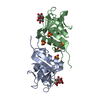

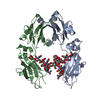






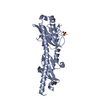

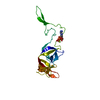

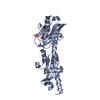


 PDBj
PDBj









